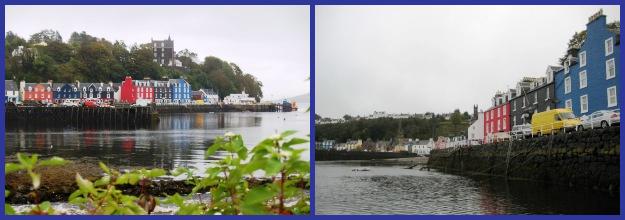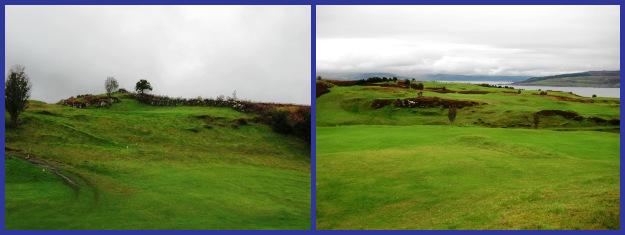A Rich Pour 28: Something To Mull Over – Discovering Tobermory Distillery
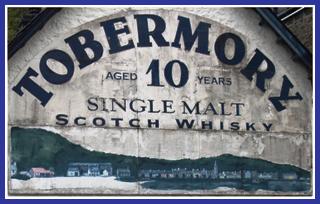
March 16, 2015
The Isle of Mull lies off the western coast of the Scottish mainland, midway between its fellow Inner Hebridean islands of Jura and Islay to the south, and Skye to the north.
Although a commercial seaplane service provides direct flights from Glasgow to Mull, most visitors and locals avail themselves of the ferries operated by Caledonian MacBrayne.
CM’s most popular (and heavily utilized) route to the island departs from Oban and docks at Craignure, on the eastern shores of Mull. The trip takes approximately 45 minutes. Two shorter crossings traverse the Sound of Mull – one from Lochaline to Fishnish, and the other from the desolate kelp and rock strewn shoreline at Kilchoan, on the remote Ardnamurchan Peninsula, to the town of Tobermory.
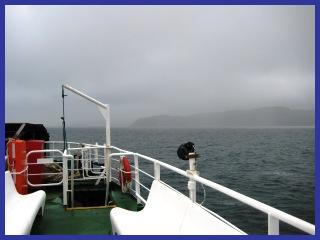
Only two other automobiles accompanied ours on the ferry’s mid-morning passage over to the Isle of Mull. I played sentinel on the upper deck during the entire crossing, braving the mist-laden breeze and relishing it. Slowly, the coastline of the Isle of Mull came into view. The ferry shifted starboard, passed the lighthouse and rounded a bluff. Tobermory’s docking ramp lay directly ahead.
The town of Tobermory
Tobermory, which dates from 1788, is a picturesque little seaport on the northeast coast of the Isle of Mull. The town sits shadowed by a steep hillside, hugging the shoreline of its bay.
Apart from the geographical constraints of its setting, one would never guess that Tobermory is home to less than a thousand inhabitants. Over the years, this picturesque little fishing community has broadened to encompass a museum and an art centre, as well numerous shops and eateries. Needless to say, there is also a distillery. When tour buses begin pulling into the civic parking lot, the population swells unimaginably.
A brief history of Tobermory Distillery
Tobermory was barely ten years old when it saw its first distillery erected. An enterprising kelp merchant, named John Sinclair, requested and received a brewery permit from the British Society for Promoting the Fisheries, then clandestinely set up a pot-still. Though he produced a mere 292 gallons of spirit in 1798, Sinclair eventually profited mightily from his copper pot operation. He retired from his post twenty-eight years later, having accumulated a small fortune through illegal whisky distillation. So much for the beer license!
Historical records indicate that Ledaig (the original name for Tobermory) Distillery’s legal establishment occurred sometime between 1823 and 1831, quite possibly under a limited partnership formed between Sinclair and a Mr. McLachlan in 1827. The site struggled through much of the 19th Century, closing in 1837 and starting up again in 1878. It was taken over by John Hopkins & Company in 1890.
The early 20th Century was no kinder to Ledaig. Despite coming into Distillers Company’s fold in 1916, the enterprise had difficulty making a go of it. The distillery finally shut down in 1924. Workmen removed the pot-stills and washbacks six years later.
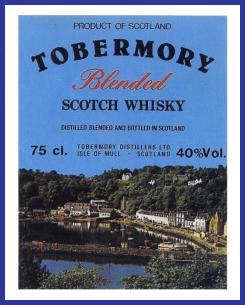
Throughout the troubled years of the 1970s and 1980s, Mull’s lone still-site marketed a confusing array of spirits. The Tobermory label adorned blends, blended malts and single malts. All of these distillates generally utilized unpeated barley. In complete contrast, heavily smoked grain – often peat-reeked to thirty-five parts per million of phenols, enough to make an Islay resident take notice – was used to produce the rarer Ledaig whiskies. But the distillery could never hope to achieve a consistent product as it groaned along at half of its operational capacity.
Fortunately, Burn Stewart, owners of Deanston Distillery in the southern Highlands, saw the abandoned Tobermory as a potential asset rather than a liability. The firm realized the site possessed a plentiful supply of natural water. And Burn Stewart viewed Tobermory’s ability to produce two distinct styles of island malt as an ideal complement to their Highland distillery’s make. The company therefore decided to rescue the island distillery from oblivion, and purchased the property during the early 1990s for a modest £800,000.
Whisky production at Tobermory Distillery
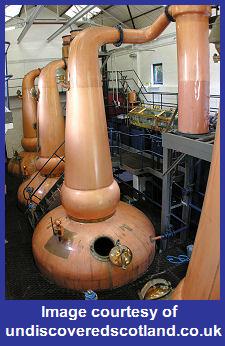 These days, Tobermory seems to have recaptured some of its late 18th and early 19th Century magic. Close-by, the peaty Mishnish Lochs feed into a couple of springs. These burns then run over basalt rock before emptying into a small holding pond. This private reservoir can provide for all of the distillery’s water needs.
These days, Tobermory seems to have recaptured some of its late 18th and early 19th Century magic. Close-by, the peaty Mishnish Lochs feed into a couple of springs. These burns then run over basalt rock before emptying into a small holding pond. This private reservoir can provide for all of the distillery’s water needs.
Toberymory’s walls shelter four copper distillation vessels. A pair of 16,000 litre spirit-stills stands next to two slightly larger wash-stills. The spirit-stills were fabricated by Grants of Dufftown back in 1972. Drastic kinks near the tops of their necks influence the purity of the emerging distillate.
Isle of Mull’s fresh whisky, whether of the milder, accessible Tobermory style or the smokier, oilier and more challenging Ledaig variety, is placed into barrels and then transported to Burn Stewart’s vaulted warehouses at Deanston, in Perthshire.
Ian MacMillan has acted as Master Blender at Tobermory ever since Burn Stewart’s takeover of the site. MacMillan has also been instrumental in the distillery’s decision to abandon chill-filtration in the production process.
A small and convivial visitor centre sits adjacent the distillery offices. Here, one can procure many of the whiskies marketed under the Ledaig and Tobermory labels.
Two of many other sites worth seeing on the Isle of Mull
Sited on a headland overlooking Tobermory Bay and the Sound of Mull, the town’s undulating golf course harks back to a David Adams design, circa 1935. However, the original Tobermory Golf Club was founded in 1896, its layout reputedly the work of the famous golf pioneer Old Tom Morris. Whatever the precise history, the nine-hole course definitely possesses an Old-World feel. Tom Watson has played here, and remarked on the challenging nature and excellence of the layout.

The whiskies of Tobermory Distillery
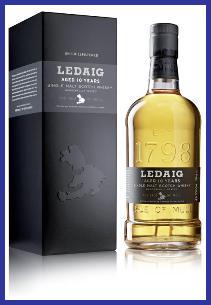

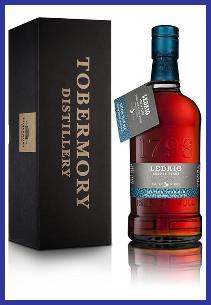
Ledaig 10 Year Old – 46.3%
Ledaig Aged Over 15 Years – 43%
Ledaig 16 Year Old – 57.2%

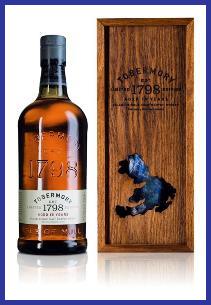
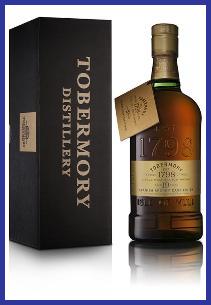
Tobermory 10 Year Old – 46.3%
Tobermory 15 Year Old Limited Edition – 46.3%
Tobermory 19 Year Old – 58.2%
By the way, Ledaig is Gaelic for “the small slope”, though it could also possibly be Norse for “a bay difficult to enter” or “safe haven”. And Tobermory is Gaelic for “Mary’s well”.
Slàinte!
Referenced books & websites
Jackson, Michael, Michael Jackson’s Malt Whisky Companion, Fourth Edition, élan press, General Publishing Company Limited, Toronto, Canada, © 1999 Dorling Kindersley Limited
Jackson, Michael, The World Guide To Whisky, Dorling Kindersley Limited, London, Great Britain, © 1987
Kuebler, Doug. The Tumbler’s Guide to Single Malt Scotch Whisky: Armchair Reference Manual & Field Guide, Topeda Hill Publishing, Baldwin Mills, Québec, Canada, © 2003
Scotland Distillery Names & Pronunciations, whiskycast.com, originally compiled by Jeroen Kloppenburg & contributors to his peatfreak.com site
The Tobermory Distillery web-site, tobermorydistillery.com




